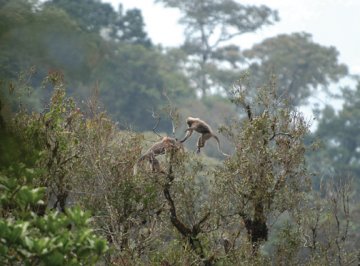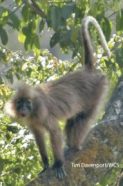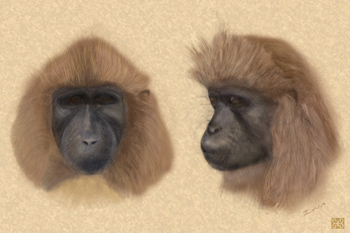New Monkey Business
A rare, recently discovered monkey differs from other known types of monkeys.
By Emily Sohn
A new kind of monkey is giving scientists a lot to think about.
Two groups of researchers independently discovered the rare creature in different forests in Tanzania last year (see “New Mammals”). They classified the shy animal as a mangabey, a type of primate, and gave it the species name Lophocebus kipunji.
The monkey, however, may not be a mangabey after all. New evidence suggests that it belongs to a brand new genus (a category that’s one step broader than species). It may fit in the primate family tree closer to baboons than it does to mangabeys.
 |
|
Scientists are proposing a new genus name for the rare, shy kipunjis. These monkeys live in groups. They travel and look for food in the forest canopy of Tanzania’s highlands. These monkeys communicate with distinctive honk barks. |
| © Tim Davenport/WCS |
When the scientists named L. kipunji, they had seen it in the wild and taken pictures of it. But they had never been able to study one up close. Then, last August, a Tanzanian farmer found a dead kipunji in a trap that he had set to catch animals that tried to eat his crops.
To better understand its place in the primate family tree, a group of international scientists collected samples of the genetic material DNA from the dead animal. Analyses of the DNA suggested that this new monkey is more closely related to baboons than it is to mangabeys.
 |
|
An adult male kipunji. |
| © Tim Davenport/WCS |
Comparisons of the young male monkey’s body to those in the baboon collection at Chicago’s Field Museum, however, told a different story. L. kipunji just didn’t fit in. It didn’t look like a baboon.
 |
|
This artist’s illustration shows a kipunji’s distinctive head and face. |
| © Zina Deretsky, National Science Foundation |
If it’s not a mangabey, and it’s not a baboon, then what is it? The researchers propose a new genus called Rungwecebus. The genus name refers to Mt. Rungwe, where this monkey was first observed. So, the monkey’s name is now Rungwecebus kipunji.
Scientists continue to debate the decision to create a new genus, but if it sticks, it would be the first new monkey genus to be recognized since the 1920s.—E. Sohn
Going Deeper:
Milius, Susan. 2006. Monkey business: Specimen of new species shakes up family tree. Science News 169(May 13):293-294. Available at http://www.sciencenews.org/articles/20060513/fob7.asp .
Sohn, Emily. 2005. New mammals. 2005. Science News for Kids (May 25). Available at http://www.sciencenewsforkids.org/articles/20050525/Note2.asp .







